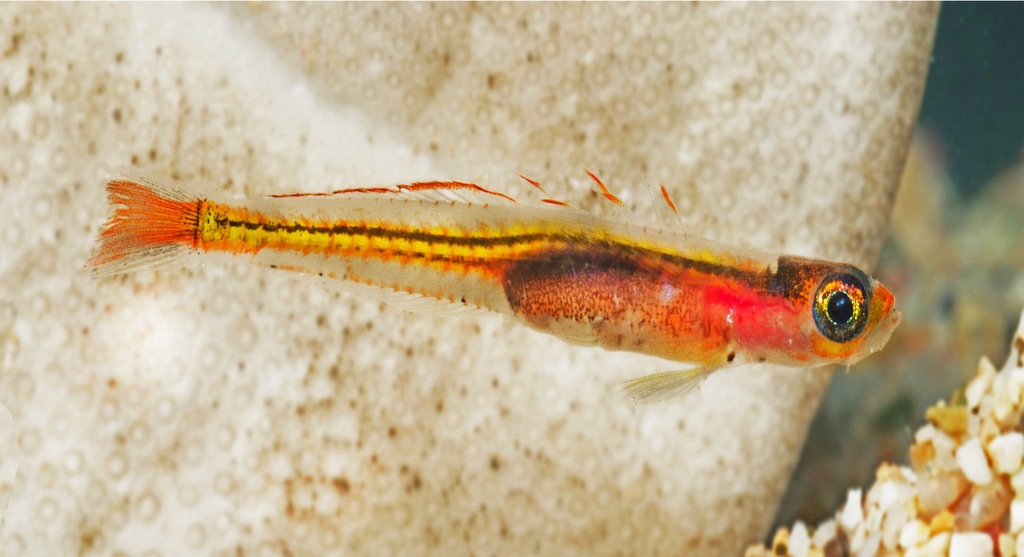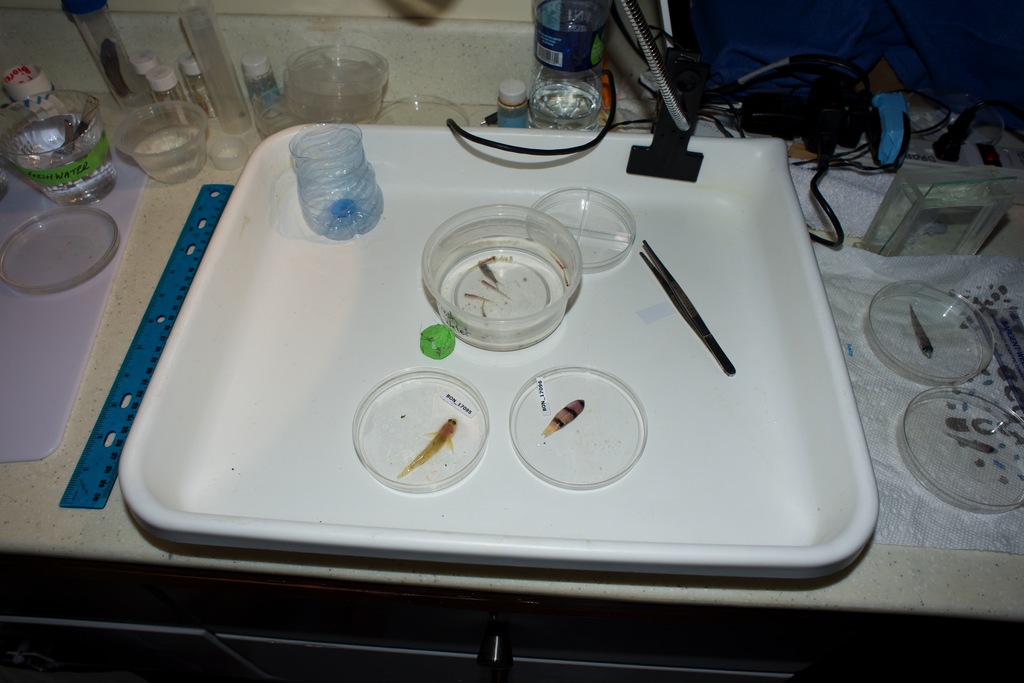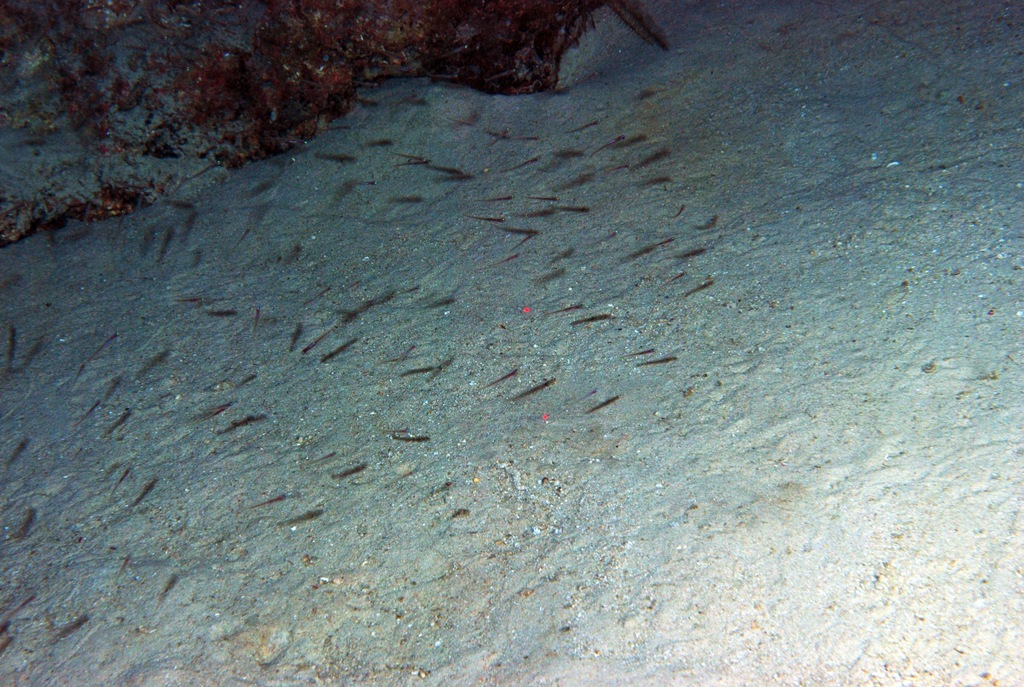Behind the science:
A new mesophotic goby, Palatogobius incendius (Teleostei: Gobiidae)...
2017, September 21
Posted by Veronica Radice
Fields
Taxonomy
Behavior
Ecology
Focusgroups
Fishes
Locations
Curaçao
Honduras - Bay Islands
Dominica
Platforms
Manned Submersible
“A new mesophotic goby, Palatogobius incendius (Teleostei: Gobiidae)”
What was the most challenging aspect of your study (can be anything from field, lab to analysis)?
The most challenging aspect is actually finding the funding to conduct this type of research. There is a misconception that funding deep-reef exploration with submersibles is too expensive to be an efficient tool. On the contrary, the submersibles we use (the Curasub and the Idabel) are far less expensive to operate than other popular subs like the Pisces submarines, Alvin, and others, and even cheaper than some of the larger ROVs. In addition, the subs we use allow us to go deeper than rebreather divers, stay down longer, and unlike other deep-diving subs/ROVS, ours are uniquely equipped for finding and catching live fishes – a feat that robots been unable to accomplish thus far. In terms of the amount and quality of data collected per dollar spent, research submersibles like the Curasub and Idabel are some of the most efficient tools in exploring the ocean. With the deteriorating state of shallow coral reefs worldwide and the questionable status of reefs at mesophotic depths and beyond, we need to take advantage of every tool available to learn about the health of these important ecosystems before its too late.
What was the most memorable moment in undertaking this study?
The most memorable moment for me was the moment I first saw a photograph of the new species. In taxonomy, the "ah ha!" moment when you realize you are dealing with an undescribed species usually comes long after its collected. Maybe it happens in the lab after you've counted and measured lots of features from dozens of specimens and compared them to other species, or sometimes it happens when you look at the results of a genetic analysis. But with this study, as soon as I saw the live photograph of the first specimen collected, Carole Baldwin and I knew immediately that this was something we hadn't seen before. And that was exciting! It was so strikingly different from everything in that group of fishes we were familiar with, so the "eureka!" moment happened pretty early on. The next "eureka" moment was more somber, and that of course was when we saw the species getting eaten by the lionfish. We had suspected all along that lionfish were probably eating deep-reef taxa, and we knew many of those same taxa were new to science, but catching it on video was the hard evidence we needed to show that.
 New species of goby Palatogobius incendius (Teleostei: Gobiidae) discovered from mesophotic reef. This photograph is a specimen of P. incendius that was collected by the Curasub and brought to the surface alive, so it could be photographed in an aquarium, capturing its brilliant color patterns.
(C) Barry B. Brown
New species of goby Palatogobius incendius (Teleostei: Gobiidae) discovered from mesophotic reef. This photograph is a specimen of P. incendius that was collected by the Curasub and brought to the surface alive, so it could be photographed in an aquarium, capturing its brilliant color patterns.
(C) Barry B. Brown
What was your favorite research site in this study and why?
This study focused on a new species, Palatogobius incendius, that at the time was only known from three locations -- Curacao, Roatan and Dominica. Since then Palatogobius incendius has popped up in other localities across the Caribbean and in large numbers, which is exciting and encouraging, given the fact that its on the lionfish's menu. Perhaps the most exciting site where I observed the new species was off Roatan, aboard the Idabel submersible. We were cruising along a stretch of reef between 150-170 m depth. The bottom was a gradual slope of sandy with patches of rocks, scattered sponges, and seafans. Over this stretch of reef for about 200 m, the water was absolutely teeming with schools of P. incendius. There were well over 1000 individuals in this one stretch of habitat, and they were impossible to miss with their tiny bright orange bodies and iridescent eyes darting and swirling in the lights of the submersible. They reminded me of the tiny, bright glowing embers and ashes that swirl and float upwards from a campfire at night when you toss on a new log. That vision helped inspire both their common name, the Ember Goby, and the scientific name "incendius" meaning fire.
Other than your co-authors, with whom would you like to share credit for this work?
As always, our team is incredibly fortunate to be able to work with the Substation Curacao team, and the crew of the R/V Chapman. They are truly a world-class operation.
 After species are brought to the surface, the team sorts them, takes length measurements, and assigns each fish a unique number that corresponds to a tissue sample. The species shown here are (top bowl) the Ember Goby (Palatogobius incendius) and The Bigtooth Cardinalfish (Paronchelius affinis), (left) the Decorated Splitfin Goby (Varicus decorum), and (right) the Banded Basslet (Lipogramma evides).
(C) Barry B. Brown
After species are brought to the surface, the team sorts them, takes length measurements, and assigns each fish a unique number that corresponds to a tissue sample. The species shown here are (top bowl) the Ember Goby (Palatogobius incendius) and The Bigtooth Cardinalfish (Paronchelius affinis), (left) the Decorated Splitfin Goby (Varicus decorum), and (right) the Banded Basslet (Lipogramma evides).
(C) Barry B. Brown
Any important lessons learned (through mistakes, experience or methodological advances)?
Through our experiences diving on deep reefs with invasive lionfish, we’ve learned that they can be incredibly difficult to catch with the submersible. The best way to understand what lionfish are eating down deep is to look at their gut contents, and for that we need specimens collected from deep reefs. So far, they seem to have a high resistance to the anesthetic we use to catch fishes, so capturing specimens for diet analysis has been challenging. We’re currently thinking about different tools that we could use to capture lionfish from the sub, but all of the options present unique obstacles. But, finding ways to work around those obstacles is the fun part of science.
Can we expect any follow-up on this work?
Our team will continue to monitor the abundance and distribution of lionfish and other deep-reef fishes around the Caribbean. We have future dives planned off Roatan, Honduras, and would love to visit several other localities throughout the region.


